Main menu
Common skin conditions

NEWS
Join DermNet PRO
Read more
Quick links
Ehlers–Danlos syndrome — extra information
Ehlers–Danlos syndrome
Last reviewed: October 2023
Author: Dr Varitsara Mangkorntongsakul, Central Coast Local Health District, NSW, Australia. Dr Yi Jia Lee, North Metropolitan Health Service, WA, Australia. January 2020. DermNet Revision August 2021 and October 2023.
Reviewing dermatologist: Dr Ian Coulson
Introduction Demographics Subtypes Causes Clinical features Complications Diagnosis Differential diagnoses Treatment Outcome
What is Ehlers–Danlos syndrome?
Ehlers–Danlos syndrome (EDS) is a group of inherited disorders that involve a genetic defect in collagen or connective tissue synthesis and structure. This results in:
- Fragile and hyperelastic skin
- Unstable and hyperextensible (hypermobile) joints
- Fragile tissue and blood vessels.
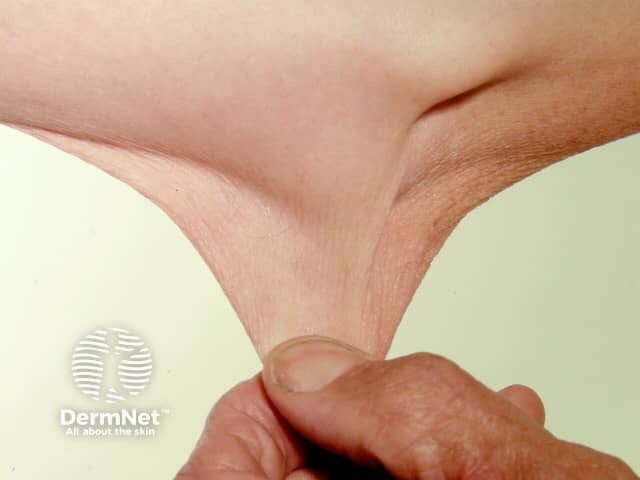
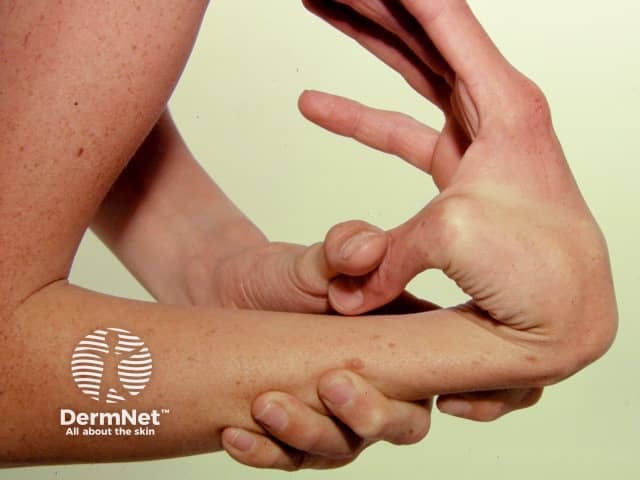
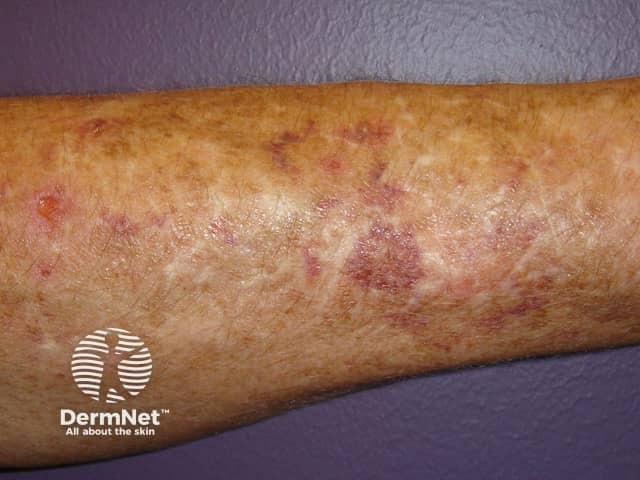
Bruises and scars
Who gets Ehlers–Danlos syndrome?
The global frequency of EDS is about 1 in 5000. EDS may occur in males and females of all races and usually first becomes apparent in childhood and young adult life.
EDS has autosomal dominant and autosomal recessive inheritance patterns.
- The autosomal dominant disease occurs when only one copy of an abnormal gene is required to cause a condition. There is a 50% chance that an offspring will inherit the abnormal gene from an affected parent.
- The autosomal recessive disease requires two copies of an abnormal gene to cause disease; therefore, a child of two carrier parents is at 25% and 50% risk of developing the disease and being the carrier of a disease, respectively.
Subtypes of Ehlers–Danlos syndrome
The 2017 International Classification for Ehlers-Danlos Syndromes, describes thirteen subtypes of EDS, classified according to the clinical features, inheritance pattern, and molecular genetic defects.
Each is a distinct disorder that ‘runs true’ in a family. This means that members of a family affected by EDS will share the same features. Some cases do not fit neatly into a known type of EDS, and a patient may show features of more than one type. Clinical manifestations and their severity can vary significantly, even within the same family.
Hypermobile EDS is the most common subtype of EDS (MIM 130020), followed by classical EDS (MIM 130000) and vascular EDS (MIM 130050). The other types of EDS are very rare (less than 10%). A 14th subtype was identified in 2018.
See Subtypes of Ehlers–Danlos syndrome
What causes Ehlers–Danlos syndrome?
Collagen is one of the main building blocks of the body. It is a protein that is widely found in the structure of many tissues and organs of the body. Several types of collagen exist, each with differing properties. Collagen can provide strength and firm support, it can be elastic to allow movement, or it can be used to bind things together.
A genetic defect can cause reduced amounts of collagen, collagen disorganisation (collagen is usually organised into bundles), and alterations in the size and shape of collagen. The subtype of EDS depends on how collagen metabolism has been affected. For example, vascular EDS is caused by decreased or absent synthesis of type III collagen.
There are some types of EDS that are a result of other extracellular matrix disorders and its components (such as glycosaminoglycans) and of defects in intracellular processing.
What are the clinical features of Ehlers–Danlos syndrome?
Signs and symptoms differ in type and severity between the different subtypes of EDS, and can be quite specific to a subtype. The characteristic clinical features of EDS are hyperextensible skin, skin fragility, easy bruising, and joint laxity.
Mucocutaneous features of Ehlers-Danlos syndrome
Classic Ehlers-Danlos syndrome (MIM 130000) has the additional cutaneous features:
- Soft velvety skin
- Normal skin recoil after stretching
- Hyperlinear loose skin on the palms and soles
- Lax skin around the eyes and face forming folds in later life
- Lack of stretch marks in pregnancy
- Wounds heal slowly to leave wide 'cigarette-paper' scars
- Molluscoid pseudotumours - spongy blue-grey lumps over pressure points and scars
- Calcified spheroids - small, firm, subcutaneous nodules on forearms and shins
- Pigmentation following repeated bruising of easily traumatised sites
- Piezogenic pedal papules.
Hyperextensibility in Ehlers–Danlos syndrome



Bruises in Ehlers–Danlos syndrome

Ehlers-Danlos syndrome
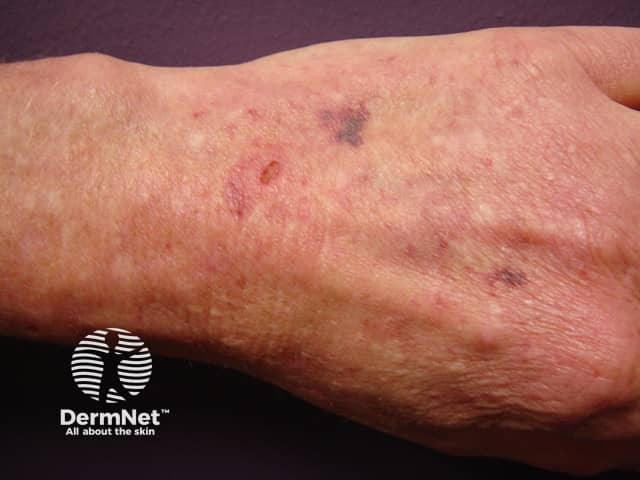
Ehlers-Danlos syndrome
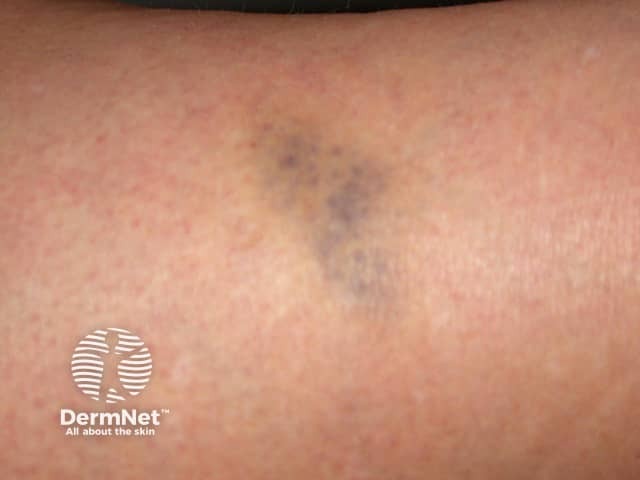
Other forms of EDS may show:
- Periodontal involvement
- Severe and intractable inflammation of the gum
- Lack of attached gum
- Skin
- Thin and translucent skin with visible underlying blood vessels and varicose veins
- Prematurely aged appearance of thin wrinkled skin particularly on hands and feet (acrogeria in vascular EDS)
- Epicanthic folds make the bridge of the nose appear wide
- Pretibial plaques
- Elastosis perforans serpiginosa
- A long philtrum and thin lips
- Lobeless ears
- Insensitivity to local anaesthetics.
Atrophic scars in Ehlers–Danlos syndrome
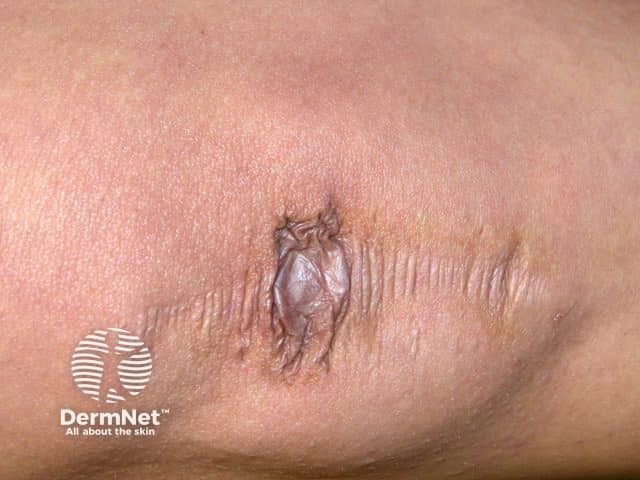
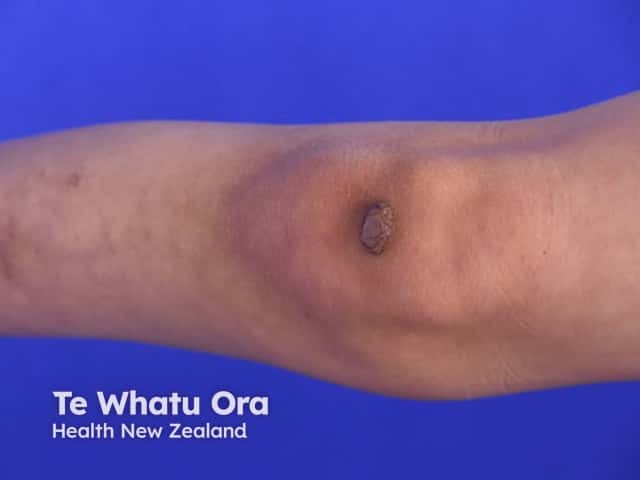
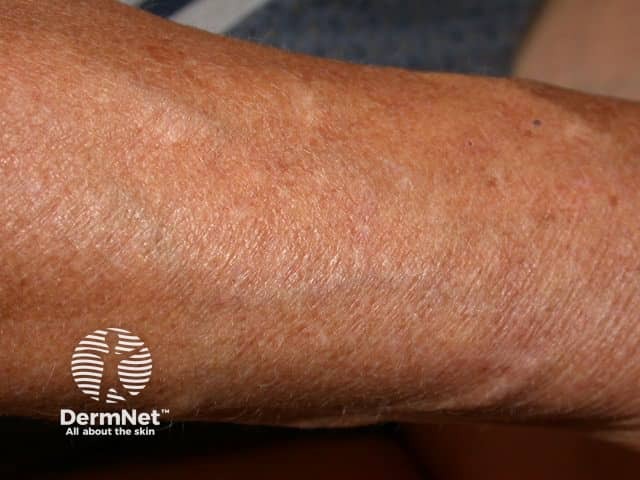
Cutaneous Ehlers–Danlos syndrome
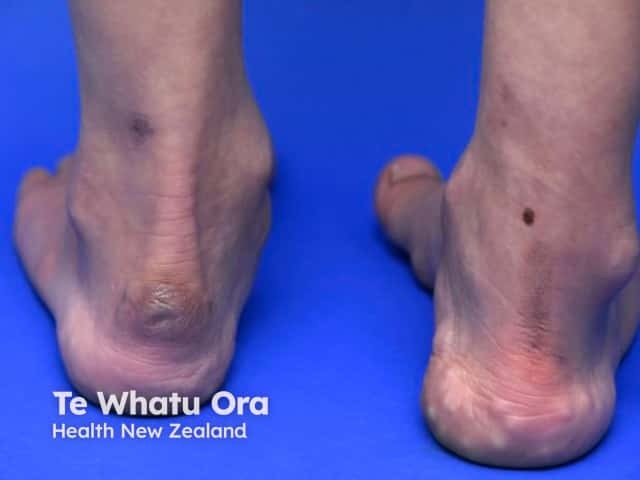
ehlers danlos syndrome

Other clinical features of Ehlers-Danlos syndrome
Symptoms and signs can be quite specific to an EDS subtype.
Musculoskeletal system
- Hypermobility — the joints bend more than usual. The fingers are most often affected, but all joints can be involved. Congenital or recurrent joint dislocations or subluxations may occur particularly in shoulders, hips and knees.
- Congenital talipes equinovarus (clubfoot) — a developmental deformity of the foot where one or both feet are rotated inwards and downwards.
- Congenital or early-onset kyphoscoliosis — an abnormal curvature of the spine.
- Arachnodactyly — abnormally long and slender fingers and toes.
- Congenital or mild, to later-onset of hypotonia and gross motor delay.
Hypermobility in Ehlers–Danlos syndrome


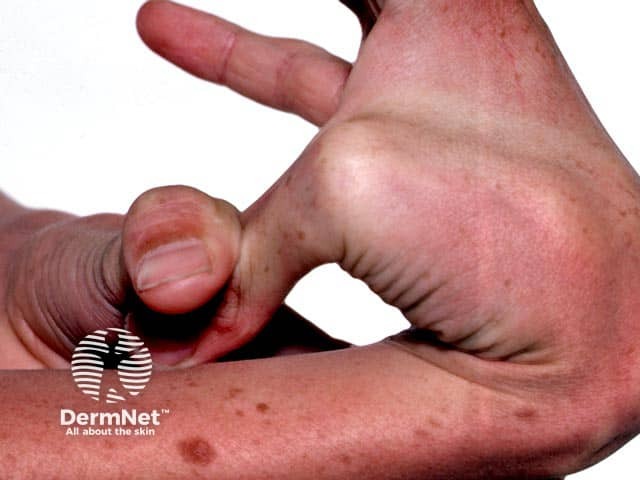
Eye
- Thin cornea, with or without rupture
- Blue sclera
- Keratoconus — the cornea has a cone-like shape
- Keratoglobus — the globular protrusion and thinning of the cornea
See more images of Ehlers–Danlos syndrome.
Internal collagen defects
- Heart murmur (mitral valve prolapse) and weakened walls of intestines, arteries, and uterus, which may rupture
- Autonomic dysfunction — transient loss of consciousness, palpitation, dizziness, chest pain, and shortness of breath
- Postural orthostatic tachycardia syndrome (POTS) — fast heartbeats, which particularly occur on postural change or standing
- Recurrent pneumothorax — these can be the initial presentation of EDS
What are the complications of Ehlers–Danlos syndrome?
Possible complications of Ehlers-Danlos syndrome include:
- Chronic joint pain
- Poor wound healing
- Failure of surgical wound closure
- Early-onset arteritis
- Premature preterm rupture of the fetal membrane
- Hollow organ and vascular rupture
- Rupture of the eyeball, retinal detachment, and glaucoma
- Epilepsy.
How is Ehlers–Danlos syndrome diagnosed?
Suspicion of Ehlers-Danlos syndrome should lead to a careful history and examination. Major and minor criteria have been developed for each of the 13 subtypes of EDS. The definite diagnosis of a specific variant requires tissue biopsy and molecular genetic analysis due to the variety of molecular defects and clinical overlap between EDS subtypes.
Medical history
Detailed personal and family history of muscle, ocular, cutaneous, dental, cardiac, and respiratory conditions.
Clinical examination
- Full skin examination — assess for hyperextensibility of the skin and abnormal scarring
- The Beighton scale — assess for hypermobility of a joint, in which a score of 5 or more indicates generalised joint hypermobility
Investigations
- Skin biopsy for histology, fibroblast culture, and electron microscopy
- When suspecting kyphoscoliotic EDS, a urine sample is taken to measure the ratio of lysyl-pyridinoline to hydroxylysyl-pyridinoline cross-links
Molecular genetic testing confirms the diagnosis, except in the case of hypermobile EDS, which has an unknown genetic basis and so is a clinical diagnosis which must meet all the clinical criteria.
What is the differential diagnosis for Ehlers–Danlos syndrome?
- Osteogenesis imperfecta
- Loeys-Dietz syndrome
- Skeletal dysplasias
- Mucopolysaccharidoses
- Cutis laxa syndrome
- Pseudoxanthoma elasticum
- Ullrich congenital muscular dystrophy
- Bethlem myopathy
- Larsen syndrome
- Achondroplasia
- RIN2 syndrome
- Marfan syndrome
- Chondrodysplasia
- Congenital myopathies
- Freeman-Sheldon syndrome
What is the treatment for Ehlers–Danlos syndrome?
Management guidelines depend on the subtype of EDS.
- Take preventative measures against serious and life-threatening complications
- Patients should consider wearing a MedicAlert bracelet to communicate their EDS status
- All patients with EDS should be referred for genetic counselling and appropriate specialists
- Beta blockade in vascular EDS has been shown to reduce mortality
General measures
- Children may benefit from protective pads and bandages
- Contact sports or activities that will raise intracranial pressure (like playing the trumpet) should be avoided to prevent undue trauma
- The patient may benefit from low-resistance exercise and physiotherapy
- Consider calcium and vitamin D supplementation to optimise bone density
- Provide psychological support following the diagnosis
- Patients should wear a medical warning bracelet inscribed 'type of EDS'
Medication
- Ascorbic acid (vitamin C) has been used to reduce bruising
Surgery and wound care
- Surgery should be carried out with caution given the risk of vascular complications
- Wounds should be carefully closed via sutures without tension
- Deep stitches are recommended; leave superficial stitches for extended periods of time to allow healing
Pregnancy
- Obstetrical follow-up throughout pregnancy is recommended due to the risk of bleeding disorders and vascular, surgical and anaesthetic complications
- Women with EDS have an increased risk of premature labour, postpartum haemorrhage, bladder and uterine prolapse, abdominal hernias, and wound dehiscence
- There are no existing obstetric management guidelines for EDS given the extensive ranges of possible implications and severity of each subtype; thus, patients are managed based on a case-by-case basis
Screening and surveillance
- The patient should have regular blood pressure monitoring and arterial disease screening to reduce the risk of bleeding and vascular complications
- Non-invasive screening — ultrasound, computed tomography (CT) scan, echocardiogram, and magnetic resonance imaging (MRI) may be performed to identify potential complications
- Invasive screening procedures should be considered with care
- Dual-energy X-ray absorptiometry (DEXA) bone density scans should be performed every few years
- Patients with kEDS should have an eye check regularly, as they are at risk of eye complications
What is the outcome for patients with Ehlers–Danlos syndrome?
The prognosis of patients with Ehlers-Danlos syndrome varies widely even within the same subtype. The majority of patients have a normal life expectancy and cognitive function. Individuals with vascular EDS may have a shorter life expectancy and are at higher risk of sudden death due to internal organ and major vessel rupture.
References
- Sobey G. Ehlers-Danlos syndrome: how to diagnose and when to perform genetic tests. Arch Dis Child. 2015 Jan;100:57-61. doi: 10.1136/archdischild-2013-304822. Journal (PDF)
- Brady AF, Demirdas S, Fournel-Gigleux S, et al. The Ehlers-Danlos syndromes, rare types. Am J Med Genet C Semin Med Genet. 2017 Mar;175(1):70-115. doi: 10.1002/ajmg.c.31550. Journal
- Malfait F, Francomano C, Byers P, et al. The 2017 international classification of the Ehlers-Danlos syndromes. Am J Med Genet Part C Semin Med Genet. 2017 Mar;175C(1):8-26. doi: 10.1002/ajmg.c.31552. Journal (PDF)
- Cortini F, Villa C. Ehlers-Danlos syndromes and epilepsy: an updated review. Seizure. 2018 Apr;57:1-4. doi: 10.1016/j.seizure.2018.02.013. Journal
- Doolan BJ, Lavallee M, Hausser I, et al. Dermatologic manifestations and diagnostic assessments of the Ehlers-Danlos syndromes: A clinical review. J Am Acad Dermatol. 2023;89(3):551-559. doi:10.1016/j.jaad.2023.01.034 Journal
On DermNet
Other websites
- Ehlers-Danlos syndrome US National Library of Medicine Genetics Home Reference
- Ehlers-Danlos Syndromes New Zealand
- Connective Tissue – geneSkin
- Jacobs JWG et al. Ehlers–Danlos syndrome: a multidisciplinary approach (2018). Book. PDF download
- Medscape Reference:
- OMIM – Online Mendelian Inheritance in Man (search term Ehlers-Danlos syndrome (EDS)
- GeneTests GeneReviews:
